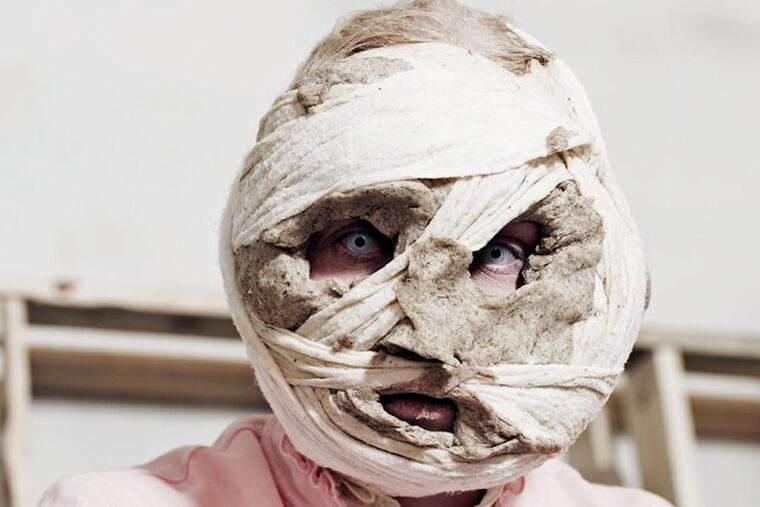Galleries: Wrestling with the uncanny at Moore
OK, I made the mistake of eating a large, healthy-looking but unexpectedly sugary cookie shortly before I went to see "The Sky's Gone Out," an exhibition at Moore College of Art and Design that examines the influence of the uncanny on contemporary art and design.

OK, I made the mistake of eating a large, healthy-looking but unexpectedly sugary cookie shortly before I went to see "The Sky's Gone Out," an exhibition at Moore College of Art and Design that examines the influence of the uncanny on contemporary art and design.
But that only partially explains the queasy feeling I experienced seeing this show inspired by Sigmund Freud's 1919 essay, "The Uncanny," which posited the uncanny as an aesthetic quality that could make the familiar appear mysterious or frightening. Even before I opened the blacked-out doors to the college's unusually dimly lit Goldie Paley Gallery - both clearly strategies of curator Kaytie Johnson to accentuate an already dread-laden atmosphere - I was anticipating the sickening sensation of terror.
It didn't grip me immediately.
There are a few disturbing images in Gabriela Fridriksdottir's poetic 2006 video, "Inside the Core," a story that suggests a Nordic myth, with echoes of Matthew Barney (she's a friend of his ex Björk) and Cindy Sherman. But it was hard not to be amused at the antics of a central character who looks alternately like Cindy Sherman (in character), Alec Guinness in Lawrence of Arabia, and Carl Sadakichi Hartmann in the 1924 version of The Thief of Bagdad.
Fridriksdottir's still-photographic portrait of herself with her head wrapped in gauze and bread dough was also funny, once I got past the initial shock of those pale blue eyes staring out from that monstrous lumpen mass. Her pedestal-mounted stuffed fabric sculptures of E.T.-like creatures in bondage are repulsive in an adorable way.
On the other hand, the show's selection of taped interviews with possessed children and adults - all purportedly authentic - who speak in that familiar deep, croaking voice reminiscent of Linda Blair's in The Exorcist, was, frankly, chilling. Listening to the tape of the medium Jack Sutton channeling the voices of dead British airmen at Bircham Newton Airfield in Norfolk, England, in the 1980s, I didn't doubt for a minute that he was communicating with the dead.
Another of the exhibition's historic components, the well-known photographs taken by the Canadian doctor Thomas Glendenning Hamilton of his paranormal experiments in the early 1900s, would seem to offer indisputable evidence of the presence of ectoplasms. I'm still mulling this over.
The sound of a hideous roar beckoned me to pull back a thick black curtain to watch a video by Chloe Piene, but the images of a young girl swimming upward from a pool and then covered in mud or blood (the video is in black-and-white) and the terrifying soundtrack kept me from entering the room and sitting on the bench to watch it. I stood there, peeking through, mesmerized by the excruciating visions and sounds of terror that Piene had conjured. Even the curtain had a vaguely claustrophobic scent that reminded me of the rancid smell of old movie theater seats.
There are many less frightening, though similarly haunting, works here, among them photographs by Karina Jonson and Hanna Liden; Mark Danielewski's book House of Leaves; a chair designed by Benjamin Rollins Caldwell/BRC Designs; a Herbie Hancock video directed by Kevin Godley and Lol Crème, and a film by Marianna Morkore of avant-garde clothing designed by the Copenhagen-based firm Barbara I Gongini.
Have a double espresso; save the cookie for later.
Less is lots
The Brooklyn-based British artist Paul Lee uses a minimum of materials to make his wall-mounted sculptures, but each one resonates with a particular personality, whether it's one of his small pieces that use a standard tambourine as a kind of canvas/support - all of which feature painted, variously shaped geometric wood forms extending from the tambourine - or wall "drawings" fashioned from strips of scruffy colored fabric.
In the Rosenwald-Wolf Gallery's spruced-up white and gray space, Lee's tactile but extremely subtle assemblages and wall "drawings" appear to float on the walls and suggest an affection for the early works of Jasper Johns, Robert Rauschenberg, Richard Tuttle, and Yoko Ono. But they are also very much of their time.